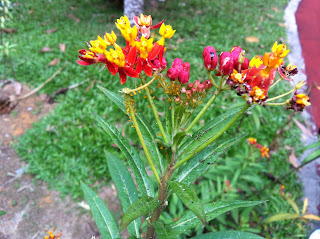Today, we (Zek Min, Beverley, Vivian and Kate) went for the weekly butterfly survey. There was a surprising amount of plain tigers around, as well as (to our delight) a Common Mime (Papilio Clytia). Attached are a few of the photos we captured of the butterflies.
 |
| Vivian and Zek Min watching the plants for the butterfly survey. |
 |
| Beverley and Zek Min during the butterfly survey |
 |
| A Plain Tiger on a Snakeweed plant |
 |
| A Plain Tiger on Lantana camara |
 |
| The Common Mime which we spotted, on Pseuderanthemum reticulatum plant |
 |
| Autumn Leaf caterpillars really like the Pseuderanthemum reticulatum plant. |
After that, we visited the Science Centre Singapore to check out what it's like (some of us haven't visited it for years) as well as to brainstorm for ideas as to what we could do for our collaboration with SCS. Yuexin and Zhang Xuan met us there.

SAYES was kind enough to let us use their clubhouse for our discussion. Eventually, we decided that hosting a workshop during the June holidays might be a better idea than a booth, as booths require quick and fun activities that can get our point across, which we could not come up with at this time. Instead, a workshop about an hour long could help us spread awareness more effectively and to more people. We will need to write up a proposal and send it to SCS to see if they can help us with it. However, we hope that we can host a booth at one of the upcoming science events hosted by SCS, such as Singapore Science Festival or Kids Science Fest, but this will really depend on how much SCS is willing to help us (big thanks to them for collaborating with us so far!)
We also discussed our Inter-House Games (IHG) plan, which will involve an amazing race. Details can't yet be put up on a public blog, but we will be working on our proposal, as well as on a booth for Open House (hopefully). Meanwhie, we are also in collaboration with a German and Filipino school, as well as RGSEC, the science and environment club in our school.
Photos are attached of our discussion.
 |
| Discussing details |
 |
| Science Centre from the view of the clubhouse. May not look like it in this picture, but it was actually quite crowded! |
 |
| Picture after the session! |
 So we had our bubble tea sale today, a fundraiser that we also hope will generate interest in our project amongst our school.
So we had our bubble tea sale today, a fundraiser that we also hope will generate interest in our project amongst our school.













































